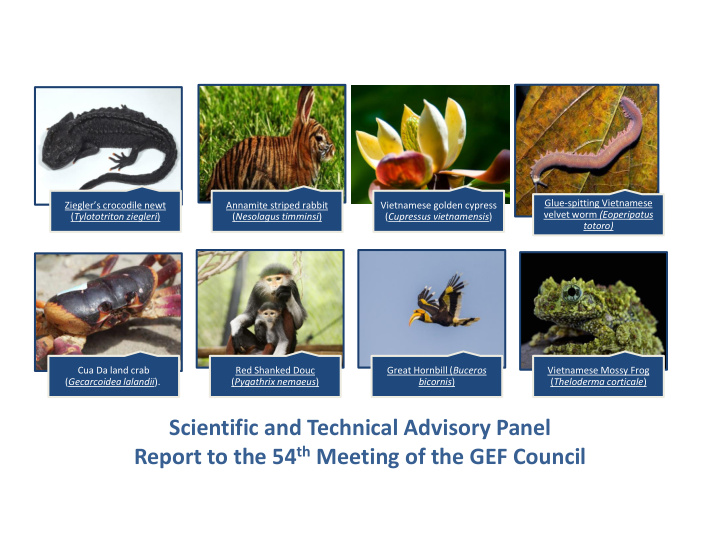



Glue-spitting Vietnamese Ziegler’s crocodile newt Annamite striped rabbit Vietnamese golden cypress velvet worm (Eoperipatus ( Tylototriton ziegleri ) ( Nesolagus timminsi ) ( Cupressus vietnamensis ) totoro) Cua Da land crab Red Shanked Douc Great Hornbill ( Buceros Vietnamese Mossy Frog ( Gecarcoidea lalandii ). ( Pygathrix nemaeus ) bicornis ) ( Theloderma corticale ) Scientific and Technical Advisory Panel Report to the 54 th Meeting of the GEF Council
STAP Panel Members Thomas Lovejoy Senior Advisor to Chair Rosina Bierbaum Chair, USA Ferenc Toth Ralph Sims Annette Cowie Brian Child Ricardo Barra Blake Ratner Climate Change Land Degradation Climate Change Biodiversity Chemicals & Waste International Waters Adaptation Mitigation Australia South Africa Chile USA Hungary New Zealand
Michael Stocking The livelihoods of most rural people are directly supported by soil; and all of us, whether in recreation or occupation or subsistence, depend upon soil as the hub of all life-supporting processes.
The 3 inter-dependent facets of sustainability
The he 3 inter-de depende pendent nt face acets ts of sustaina tainabili bility ty In 2014, STAP called for a focus on “ environmentally sustainable development” http://www.stapgef.org/stap-report-fifth-gef-assembly
Integration, Innovation, and Learning Integra egration tion Innovation Novel entities Inno novat ation on and the GEF Lear arning ning Local common, global benefits
Integration to solve complex environmental problems 1. Systems thinking 2. Theory of change & Plan B 3. Resilience planning 4. Implementation pathways 5. Knowledge management 6. Stakeholder engagement 7. Flexibility
Bringing integration to our food system TAKE MA MAKE KE WASTE TE
The circular economy food system
A future food system for healthy human beings and a healthy planet Problem : • Need to increase food production, but current “take -make- waste” system detrimental to the environment Solutions: • Reduce inputs and use resources more efficiently, without decreasing productivity Circular economy keeps resources in use, • maximizes value, recovers and regenerates at end of life - consider for the ‘Food systems, Land Use and Restoration’ Impact Program
Systems thinking needed for plastics
Syst stem ems s th thinking nking nee eeded ded for plastics stics
Plastics and the circular economy Problem • Plastics consume/affect a lot of natural resources: Oil, produces carbon dioxide – – 185 liters of water to make 1 kg of plastic – plastics ingested by marine life – Microplastics contaminate drinking water, fish • Plastics use chemical additives including POPs • Last for decades to centuries Solutions: – Renewable feedstocks – Use plastics as resources – Redesign plastics – Business and consumer collaboration – Fiscal and regulatory measures
Environmental security: dimensions and priorities STAP Assembly report 2014 encouraged more attention to environmental security: “ to enable improved human well-being, health, security, livelihoods and social equity at the same time as environmental benefits ” Environmental security is centrally important to the GEF. Relevant to all focal l areas as Many GEF operations expose osed d to confl nflict ct risk Addressing environmental security in an explici icit, t, consi nsist sten ent t and integ egrat rated ed manner is essential to deliver global environmental benefits – including the sustainability of GEF project investments.
Environmental security: dimensions and priorities Recom ommen mendati dation ons: 1. Explicitly address environmental security in project and program design 2. Consider use of protocols from GEF agencies (including UNDP, UN Environment and World Bank, etc.) to assess conflict risk 3. Evaluate links between environmental change and vulnerability in GEF interventions 4. Contribute to conflict prevention through environmental cooperation
Innovation “… an idea, embodied in a technology, product or process, which is new and creates value…To be impactful, innovations must also be scalable, not merely one- off novelties” Five domains: - Technological - Business model - Institutional and social - Policy - Financing
Novel entities Novel entities ties are broadly defined as, “things created and introduced into the environment by human beings that could have positive or negative disruptive effects on the earth system; and may include synthetic organic pollutants, radioactive materials, genetically modified organisms, nanomaterials, microplastics.” Impor ortanc tance e – past t novel l enti titi ties es: • CFCs CFCs ozone depletion POP OPs impact on ecosystems, biodiversity • and human health
Novel entities: examples Gene e editing ting: modif ificat cation ion of DNA of organisms isms +Cacao and maize plant - climate change adaptation +Controlling methane emission in ruminants +Saving endangered species or eradicating invasive species - But threat to biodiversity, ecosystems Techn hnol ological ogical critical cal elemen ments ts (rare earth elemen ents) ts): needed ed for green n and emergi ging ng technol nologies gies - But chemical pollution, biodiversity loss, deforestation, and land degradation Cellular ar agricul cultu ture: e: producin cing g livest estock ock products cts from cell cultu tures es without out the animal al itsel elf +Help reduce the environmental footprints of current food production systems ? But regulation, ethical concerns, and public acceptance
Learning Knowledge management essential for: • Maximize GEBs • Evaluating best practices • Scaling-up • Transformational change Recommendations: • 5% set-aside for KM applied in all programmes/projects
Local commons for global benefits • Community-based natural resource management is a local approach to sustainability problems • Applicable where poverty and biodiversity losses overlap • 4 key elements: – Ownership – Price – Governance – Co-learning and adaptive management
Preliminary GEF-7 Work program • Integration – Climate risk screening – Stakeholder engagement in socio-ecological transformations – Land Degradation Neutrality guidelines – Reducing climate vulnerability and climate adaptation • Innovation – Remote sensing – Aquaculture contributions to nutrition security, climate mitigation, and land restoration • Learning – Development of a global mercury platform – Estimating environmental impact of C&W projects – Continue to press for monitoring, evaluation and learning in screening
Preliminary GEF-7 Work program • Continue to contribute to the Food Security, Commodities, and Cities IAPs • And work with the GEF partnership on designing the new Impact Programs
Recommend
More recommend